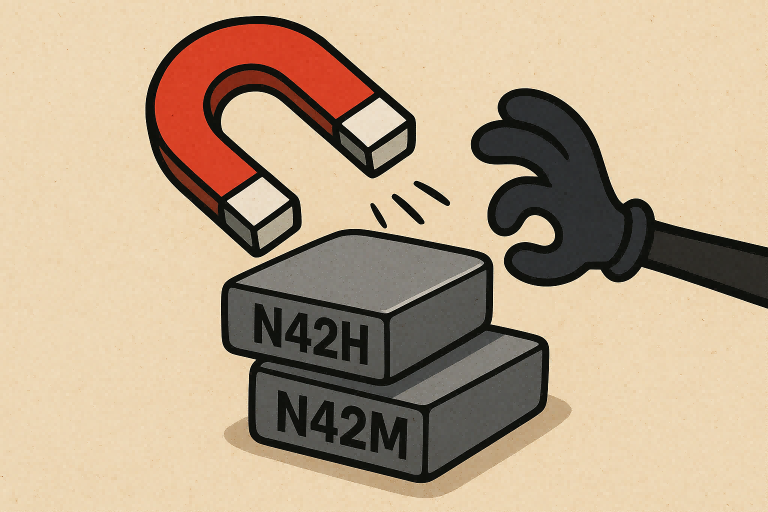
In the world of sintered NdFeB (neodymium-iron-boron) magnets, performance is defined not only by magnetic strength but also by intrinsic coercivity (Hcj) — the key parameter that determines a magnet’s ability to resist demagnetization at elevated temperatures.
According to international standards, different magnet grades are categorized based on their Hcj ranges. For instance:
- N42M typically requires an Hcj of 14–17 kOe,
- N42H requires 17–20 kOe.
On paper, this looks straightforward. But in practice, things are more nuanced — and sometimes, less transparent.
The Gray Zone Between Technical Control and Ethical Boundaries
Modern magnet manufacturers can precisely control the Hcj value during production. This means a producer can easily fine-tune magnets to specific coercivity levels within or even between these ranges.
However, since most customers do not have the equipment to measure Hcj themselves, they must rely entirely on the manufacturer’s test report. This creates an imbalance of information — and, unfortunately, opportunities for manipulation.
Let’s take a common example.
A customer requests N42H magnets. The sales person provides a quotation, but the customer feels it’s too high. In some cases, the sales team might “adjust” the offer by secretly switching to an N42M magnet (with an Hcj around 14–15 kOe), still labeling it as N42H and providing falsified test data.
The result? The customer receives a lower-cost, lower-performance magnet while believing they’ve purchased a higher-grade product. In the industry, this unethical practice is known as “stealing performance.”
Why Many Customers Don’t Notice
The issue is further complicated because many users — even some engineers — do not fully understand what Hcj represents. They may simply follow what others in the industry are using, specifying grades by imitation rather than by technical need.
Even when engineers clearly understand the parameter, many designs include performance redundancy: the magnets are intentionally over-specified to ensure safety margins. So when a supplier “steals performance,” the product may still pass standard lab or short-term validation tests.
However, problems often arise under extreme or continuous operating conditions — such as prolonged high-speed motor operation, elevated temperatures, or aggressive duty cycles. In these cases, the magnet’s true performance ceiling is reached, and its insufficient coercivity can lead to partial demagnetization, loss of torque, or long-term reliability issues that are difficult to trace back to the root cause.
There is another, equally common scenario that makes “stealing performance” easier: the customer’s design does not actually require the higher coercivity they specified, yet they supply specifications or drawings that call for a high-grade magnet (often because they copied a competitor’s spec or used a conservative template). When a design calls for over-specified magnets that the application doesn’t need, unscrupulous suppliers have an even larger window to substitute lower-performance material without immediate detection.
The Real Cost of “Stealing Performance”
At first glance, such shortcuts may seem harmless — especially if the system still “works.” But the long-term risks are significant:
Reduced reliability: magnets may lose performance over time or at high temperature.
Inconsistent quality: batch-to-batch variations cause unstable product performance.
Damaged trust: once exposed, such practices harm the reputation of the entire industry.
Within the same grade, production cost differences should typically fall within 15–20%.
So when a quotation differs by 30% or more, it’s often a red flag — an indication that the product’s declared grade might not reflect its true performance.
Integrity in Engineering
As an engineer, I hold one simple belief: technical integrity is non-negotiable.
We never use deceptive practices to close deals. If our quotation appears higher, it’s likely because we are offering true, verified performance — not a manipulated one.
Unfortunately, new customers may not immediately recognize the difference. They might suspect we are “playing tricks,” when in fact we are simply being transparent about real magnet performance and the cost required to achieve it.
But as the saying goes: time reveals truth. Over time, customers come to recognize the consistency, reliability, and honesty behind genuine quality.
Closing Thought
NdFeB magnet technology is complex — not something that can be judged by appearance or a simple magnetic test. That’s why integrity matters so much.
Every magnet we deliver represents not just a product, but a promise: that what we declare, we deliver.
In the end, technical excellence and ethical commitment must go hand in hand — because while performance can be engineered, trust must be earned.
